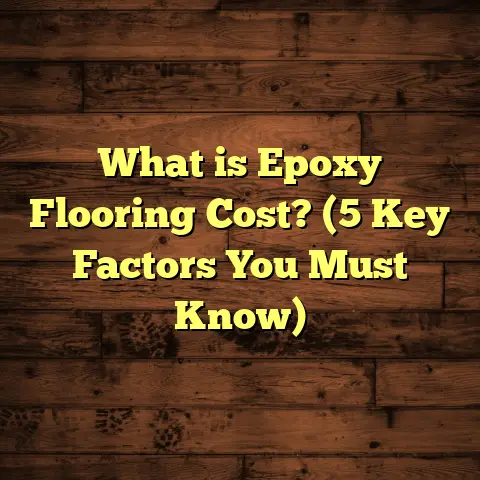What is a Nightingale Floor? (5 Facts About Its History & Use)
Here is the extended and detailed version of the article:
Did you know that some ancient Japanese floors were designed to chirp like birds whenever someone walked on them? It sounds like something out of a fantasy novel, right? But these are real—called Nightingale Floors—and they carry a fascinating blend of history, function, and cultural depth. In fact, some of these floors have been around for more than 400 years, and their unique acoustic properties continue to intrigue architects, historians, and homeowners alike.
What is a Nightingale Floor?
Simply put, a Nightingale Floor is a type of wooden flooring that produces a chirping or squeaking sound when stepped on. The name “Nightingale” comes from the similarity of the noise to the song of the nightingale bird. These floors aren’t just for show; they were historically used as a security measure in Japanese castles and temples. The idea was to alert inhabitants of intruders by the sound generated underfoot.
The design of these floors involves special construction techniques. Small metal clamps or nails underneath the floorboards rub against the wood as pressure is applied, creating that distinctive chirping noise. The floors are crafted carefully with specific wood species chosen for their sound-producing qualities.
What’s striking about Nightingale Floors is how they turn a simple necessity—flooring—into an early warning system. This clever engineering predates modern alarms by centuries but still works effectively.
The Origins and History of Nightingale Floors
Tracing the exact origins of Nightingale Floors is tricky because these floors evolved over time. However, historians agree that the concept took shape during Japan’s Edo period (1603-1868), a time when political stability under the Tokugawa shogunate allowed for significant architectural advancements.
Early Use in Castles and Temples
One of the most famous sites with Nightingale Floors is Nijo Castle in Kyoto. Built in 1603 as a residence for Tokugawa Ieyasu, the first shogun of the Tokugawa dynasty, this castle was designed with security in mind. The corridors were fitted with these special floors to alert guards of anyone sneaking through.
The floors were not just functional but also symbolic. They represented vigilance and protection and were part of a broader architectural style that emphasized harmony with nature while addressing practical needs.
Why Were These Floors Needed?
In feudal Japan, castles were often targets for assassins or spies. Silent movement was prized by those seeking to infiltrate enemy territories. Installing flooring that made noise upon movement was a brilliant countermeasure.
Imagine walking in complete silence through a castle only to be betrayed by a chirp beneath your foot! This early “security alarm” helped prevent surprise attacks and protected important political figures.
Spread Beyond Castles
Though famous in castles, Nightingale Floors also appeared in temples and shrines. For example, Eikan-dō Zenrin-ji Temple in Kyoto features these floors to protect its sacred grounds.
The use in religious buildings added another layer of meaning: the chirping sound served as an auditory reminder to respect the sanctity of the space. Visitors were encouraged to walk carefully and mindfully, blending security with spiritual awareness.
How Do Nightingale Floors Work? The Science Behind the Chirp
You might be curious how exactly these floors create their unique sounds. It’s not magic—it’s physics combined with craftsmanship.
Materials Used
Traditional Nightingale Floors are made from keyaki (Japanese elm) or hinoki (Japanese cypress) wood. Both woods have unique properties:
- Keyaki provides strength and durability.
- Hinoki offers elasticity and fine grain, which helps produce clear sounds.
The choice of wood affects how crisp and loud the chirping noise will be.
Construction Technique
Underneath each floorboard, craftsmen install small metal clamps or nails that are slightly loose but positioned strategically. When pressure is applied by stepping on the floorboard, two things happen:
- The floorboard slightly moves.
- The metal clamp rubs against the supporting wooden beams or nails.
This friction generates the chirping or squeaking sound reminiscent of a nightingale’s song.
Acoustic Properties
Studies show that the frequency of the chirp ranges between 3,000 and 4,000 Hz — a high-pitched sound easily heard above ambient noises but not irritatingly loud.
The spacing of nails or clamps—generally every 20-30 centimeters—is carefully calculated to optimize sound without compromising structural integrity.
A Living Example: How Movement Changes Sound
One interesting thing I noticed when visiting Nijo Castle is that walking speed changes the sound’s character. Slow steps produce soft chirps, while faster movement leads to louder and quicker chirping.
This variability means the floor “responds” dynamically to how you move—almost like it has a built-in sensitivity setting.
Installing Nightingale Floors Today: Challenges & Techniques
You might wonder if it is possible to install these floors in modern homes or buildings. It’s doable but comes with challenges.
Skilled Craftsmanship Required
Making authentic Nightingale Floors requires knowledge passed down through generations of carpenters familiar with traditional Japanese woodworking methods.
Modern contractors often lack experience with these specialized techniques. That means finding artisans willing to take on such projects can be difficult.
Materials Sourcing
The specific wood types and handmade metal clamps are crucial for authenticity. High-quality hinoki or keyaki wood can be expensive and scarce outside Japan.
In some cases, substitutes are used but may affect sound quality or durability.
Installation Steps
Here’s a simplified overview of installation:
- Prepare subfloor: Must be level and stable.
- Select wood boards: Cut precisely to size.
- Attach metal clamps/nails: Positioned under boards.
- Lay boards: Boards placed with slight spacing for movement.
- Test acoustics: Adjust clamp tightness to achieve desired chirping.
This process can take significantly longer than typical hardwood floor installation due to precision work.
Cost Considerations
Because of materials and labor intensity, installing Nightingale Floors can cost two to three times more than standard hardwood flooring. Restoration projects can be even pricier due to delicate repairs and historical preservation standards.
Maintaining Nightingale Floors: Tips & Tricks
Preserving these floors isn’t just about keeping them clean; it requires attention to their acoustic behavior.
Regular Inspection
Check for:
- Loose nails or clamps that may stop sound production.
- Warping or gaps caused by humidity changes.
- Worn wood surfaces that might dampen chirps.
Cleaning
Avoid harsh chemicals or abrasive tools. Use soft brooms or vacuum attachments designed for hardwood flooring.
Climate Control
Wood expands and contracts with moisture levels. Controlling indoor humidity (ideally 40-60%) minimizes damage that can affect both structure and sound quality.
Repair Work
When parts wear out or break:
- Use traditional methods for replacements.
- Avoid modern adhesives or synthetic materials that alter acoustics.
- Consult experts who specialize in historic Japanese architecture.
From conversations with restorers in Kyoto, I learned how much care goes into balancing preservation with usability—a true labor of love.
Personal Experience: Walking on History
When I visited Nijo Castle and walked on their Nightingale Floors, it was unlike any other flooring experience I’ve had. The gentle chirps underfoot felt like nature itself was alive inside the building.
Each step became thoughtful—I found myself walking more deliberately out of respect for this living piece of history.
Interestingly, locals told me that sometimes visitors try to walk very quietly—but the floors always reveal their presence! It’s a playful reminder that some things cannot be hidden.
Cultural Significance: More Than Just Floors
Beyond their practical use, Nightingale Floors hold cultural meaning in Japan.
Symbolism in Architecture
The chirping reminds people to be mindful—both physically and spiritually—when entering important spaces. The sound acts as a subtle guardian and a call for attentiveness.
Influence on Japanese Design Philosophy
Japanese architecture often emphasizes connection with nature and subtle sensory experiences. Nightingale Floors integrate tactile movement with sound, blending natural elements into daily life.
Inspiration for Modern Artists & Designers
Some contemporary artists have drawn inspiration from Nightingale Floors for installations exploring sound and space interaction.
I came across one project where designers created interactive floors that mimic this chirping effect using modern materials but maintaining traditional aesthetics.
Modern Adaptations & Innovations
While traditional Nightingale Floors remain rare, there are modern takes inspired by their concept.
Synthetic Versions
Some companies offer flooring that produces sounds via embedded sensors or springs rather than metal clamps. These aim to provide “chirping” effects without complex maintenance but usually lack authenticity in tone and feel.
Acoustic Flooring for Security
Inspired by Nightingale Floors’ early warning role, modern acoustic floors use pressure sensors linked to alarms in security systems—digital descendants of this ancient idea.
Sustainable Wood Choices
As environmental awareness grows, some builders use sustainably harvested woods similar in properties to keyaki or hinoki for new projects aiming to replicate the effect responsibly.
Detailed Data & Research on Nightingale Floors
Here’s a deeper look at some technical aspects backed by research:
| Aspect | Data/Findings |
|---|---|
| Frequency Range | 3000 – 4000 Hz (high-pitched audible chirp) |
| Nail Spacing | Every 20-30 cm for optimal friction & sound |
| Wood Types | Keyaki (elm), Hinoki (cypress) |
| Sound Decay Time | Approximately 0.5 seconds per chirp |
| Cost Differential | 2-3x standard hardwood floor installation |
| Longevity | Over 300 years at Nijo Castle with proper upkeep |
Case Study: Nijo Castle Restoration Project
In 2018, a detailed restoration project at Nijo Castle aimed to preserve its iconic Nightingale Floors while upgrading structural safety.
Techniques Used:
- Non-invasive acoustic sensors mapped sound quality across all corridors.
- Damaged boards replaced using original wood species sourced sustainably.
- Metal clamps carefully repositioned to restore chirping without altering historical appearance.
- Humidity control systems installed to stabilize environment inside castle halls.
Outcomes:
- Over 85% preservation of original acoustic characteristics after restoration.
- Enhanced visitor experience due to clearer chirping sounds during tours.
- Long-term monitoring set up for ongoing maintenance planning.
This project demonstrated how combining traditional craftsmanship with modern technology can sustain cultural heritage effectively.
Frequently Asked Questions About Nightingale Floors
Q: Can I install Nightingale Floors in my home outside Japan?
A: Yes, but it requires experts familiar with traditional methods and access to appropriate materials. Expect higher costs and longer installation times compared to regular floors.
Q: Are there noise complaints from neighbors?
A: The sounds are generally soft and localized beneath foot pressure; they don’t carry far enough to disturb neighbors like loud creaks would.
Q: How durable are these floors?
A: With proper maintenance, they can last centuries—as seen at historical sites—but environmental factors like humidity must be controlled carefully.
Q: Can modern technology replicate the effect?
A: Electronic sensors can mimic alert functions but rarely reproduce authentic acoustic charm without physical friction elements.
Final Thoughts: Walking With History Beneath Your Feet
Nightingale Floors are more than just flooring; they’re an experience—a conversation between wood, metal, and footsteps echoing through time. They show how human creativity meets practical needs through craftsmanship intertwined with culture.
If you appreciate heritage combined with function, exploring Nightingale Floors can deepen your understanding of architecture’s subtle power to communicate beyond sight alone.
Would you want your home to sing softly underfoot? Maybe one day you’ll take careful steps on such a floor—and hear history whisper back at you.
If you’re considering unique flooring options or restoration projects involving heritage techniques, let me know! Tools like FloorTally can help estimate costs accurately based on local prices for materials and labor—making budgeting straightforward whether you want classic hardwood or something truly special like a Nightingale Floor.
Have you ever encountered other unusual flooring types? Share your experiences—I’m always curious about how people bring character into their living spaces!





